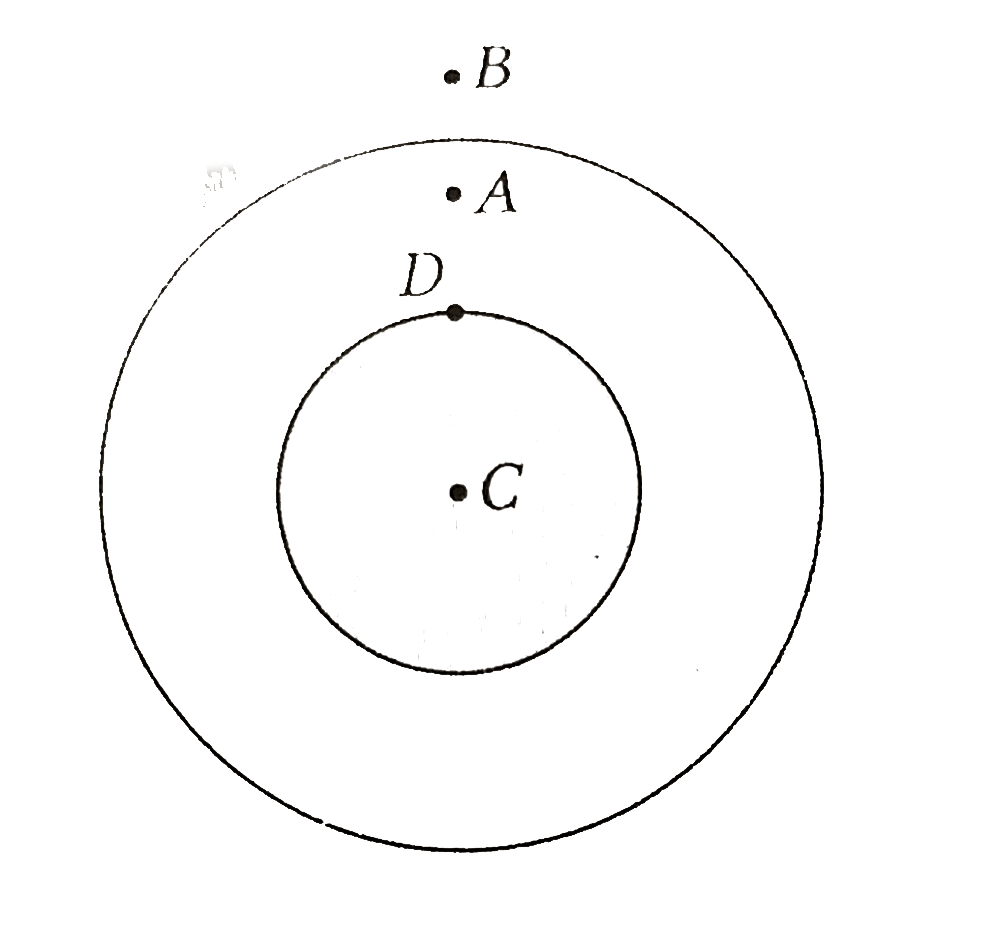Density of a planet is two times the density of earth. Radius of this planet is half. Match the following (as compared to earth)
Column-IColumn-II(A)Accleration due to gravity on this planet's surface(p)Half(B)Gravitational potential on the surface(q)Same(C)Gravitational potential at centre(r)Two times(D)Gravitational field strength at centre(s)Four times
The correct Answer is:(A→q,B→p,C→p,D→q)
To solve the problem, we need to analyze the relationships between the parameters given for the planet and Earth.
Given:
- Density of the planet, ρp=2ρe (where ρe is the density of Earth)
- Radius of the planet, rp=12re (where re is the radius of Earth)
Step 1: Calculate the acceleration due to gravity on the planet's surface (gp)
The formula for acceleration due to gravity is given by:
g=GMr2
Where M is the mass of the planet. The mass can be expressed in terms of density and volume:
M=ρ⋅V=ρ⋅43πr3
For the planet:
Mp=ρp⋅43πr3p=(2ρe)⋅43π(12re)3
Calculating Mp:
Mp=(2ρe)⋅43π⋅18r3e=13ρe⋅4πr3e=13Me
Now substituting Mp into the formula for gp:
gp=GMpr2p=G⋅13Me(12re)2
Calculating gp:
gp=G⋅13Me14r2e=43⋅GMer2e=43ge
Step 2: Gravitational potential on the surface of the planet (Vp)
The gravitational potential V is given by:
V=−GMr
For the planet:
Vp=−GMprp=−G⋅13Me12re
Calculating Vp:
Vp=−23⋅GMere=−23Ve
Step 3: Gravitational potential at the center of the planet
The gravitational potential at the center of a uniform sphere is given by:
Vc=−32GMr
For the planet:
Vc,p=−32⋅GMprp=−32⋅G⋅13Me12re
Calculating Vc,p:
Vc,p=−32⋅23⋅GMere=−GMere=Ve
Step 4: Gravitational field strength at the center of the planet
The gravitational field strength gc at the center of a uniform sphere is zero.
Summary of Results:
- gp=43ge (not listed in options)
- Vp=−23Ve (not listed in options)
- Vc,p=Ve
- gc=0
Matching:
- (A) gp → (p) Half (Incorrect)
- (B) Vp → (q) Same (Incorrect)
- (C) Vc,p → (r) Two times (Incorrect)
- (D) gc → (s) Four times (Incorrect)
Final Matching:
- (A) → (p) Incorrect
- (B) → (q) Incorrect
- (C) → (r) Incorrect
- (D) → (s) Incorrect
- Density of the planet, ρp=2ρe (where ρe is the density of Earth)
- Radius of the planet, rp=12re (where re is the radius of Earth)
- gp=43ge (not listed in options)
- Vp=−23Ve (not listed in options)
- Vc,p=Ve
- gc=0
- (A) gp → (p) Half (Incorrect)
- (B) Vp → (q) Same (Incorrect)
- (C) Vc,p → (r) Two times (Incorrect)
- (D) gc → (s) Four times (Incorrect)
- (A) → (p) Incorrect
- (B) → (q) Incorrect
- (C) → (r) Incorrect
- (D) → (s) Incorrect
Topper's Solved these Questions
- GRAVITATIONBOOK - DC PANDEY ENGLISHCHAPTER - GRAVITATIONEXERCISE - (C) Chapter Exercises
45 Videos
- GRAVITATIONBOOK - DC PANDEY ENGLISHCHAPTER - GRAVITATIONEXERCISE - (A) Chapter Exercises
68 Videos
- GENERAL PHYSICSBOOK - DC PANDEY ENGLISHCHAPTER - GENERAL PHYSICSEXERCISE - INTEGER_TYPE
2 Videos
- KINEMATICSBOOK - DC PANDEY ENGLISHCHAPTER - KINEMATICSEXERCISE - INTEGER_TYPE
10 Videos
Similar Questions
Match the following :
Column -IColumn -II(A)Acceleration due to gravity(p)Kepler's law(B)Law of periods(q)Vector quantity(C)Orbital speed(r)Uniform near earth surface(D)Gravitational potential(s)Is nearly zero at infinity
View SolutionTwo concentric spherical shells are as shown in figure. Match the following columns

Column-IColumn-II(A)Potential at A(p)greater than B(B)Gravitational field at A(q)less than B(C)As one moves from C to D(r)Potential remains constant(D)As one moves from D to A(s)Gravitational field decreases(t)None
View SolutionIf earth decreases its rotational speed. Match the following columns
Column-IColumn-II(A)Value of g at pole(p)Will remain same(B)Value of g at equator(q)Will increase(C)Distance of geostationary(r)Will decrease(D)Energy of geostationary satellite(s)Cannot say
View SolutionIn elliptical orbit of a planet, as the planet moves from apogee position to perigee position to perigee position, match the following columns
Column-IColumn-II(A)Speed of planet(p)Remains same(B)Distance of planet from centre of sun(q)Decreases(C)Potential energy(r)Increase(D)Angular momentum about centre of sun(s)Cannot say
View SolutionIf radius if earth is reduced to half without changing its mass, then match the following columns
Column-IColumn-II(A)Angular momentum of earth(p)Will become two times(B)Time period of rotation of earth(q)Will become four times(C)Rotational kinetic energy of earth(r)Will remain constant(D)(s)None
View SolutionA planet moves in elliptical around sun, at one of focal points. Match the following, for different parameters related to the planet during the motion
Column IColumn II(A)Kinetic energy(p)Maximum at perigee(B)Gravitational potential energy(q)Minimum at perigee(C)Linear momentum(r)Maximum at apogee(D)Area swept per second radius(s)Minimum at apogee
View SolutionMatch the following columns. (for a satellite in circular orbit)
Column-IColumn-II(A)Kinetic energy(p)−GMm2r(B)Potential energy(q)√GMr(C)Total energy(r)−GMmr(D)Orbital speed(s)GMm2r
View SolutionIf the density of the planet is double that of the earth and the radius 1.5 times that of the earth, the acceleration due to gravity on the planet is
View SolutionMass and radius of a planet are two times the value of earth. What is the value of escape velocity from the surface of this planet?
View SolutionMatch the following columns
Column-IColumn-II(A)Time period of an earthsatellite in circular orbit(p)Independent of mass of satellite(B)Orbital velocity of satellite(q)Independent of radius of orbit(C)Mechanical energy of satellite(r)Independent of mass of earth(s)None
View Solution
